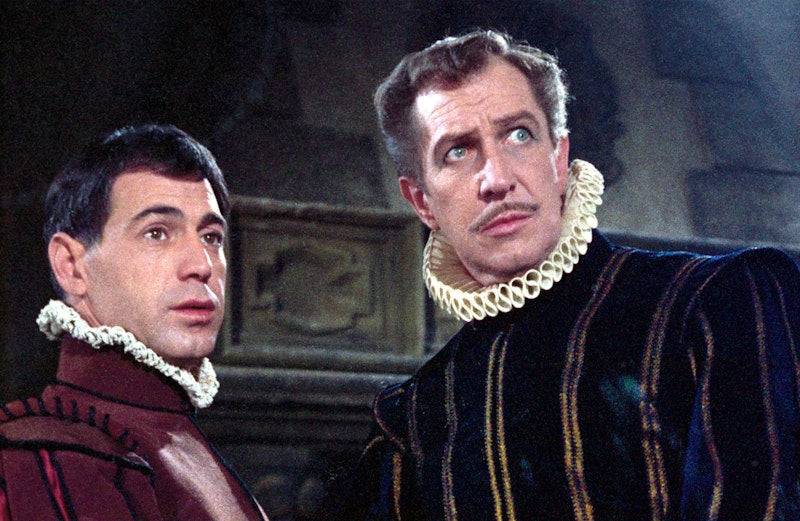In 1961 Roger Corman released his second adaptation of an Edgar Allan Poe short story, The Pit and the Pendulum. The House of Usher, released the year before, was a hit, so the follow-up kept much of the same feel, bringing back screenwriter Richard Matheson and star Vincent Price—as well as Usher’s editor, music director, cinematographer, and art director, along with sundry other crew members. The result was another critical and commercial success. Corman may have found a formula, but it was a formula that spoke to its moment, at a time when film, especially horror film, was going through major change.
This was a moment when movies were making a wholesale move to color. A moment when independent film companies were flourishing—including American International Pictures, who were behind Corman’s Poe movies. And a moment when the production code of the major studios was breaking down, which had particular relevance for horror films.
The fairly restrained horror of the 1950s was fading away. In 1960 Alfred Hitchcock released Psycho. In Italy the same year Mario Bava’s violent Black Sunday was released. And Britain’s Hammer Films had startled Americans with their 1958 versions of Dracula and Frankenstein. Corman knew he was competing with Hammer, and you can see that same Gothic approach in his Poe movies—which would go on to influence Bava and an upcoming wave of Italian horror maestros.
The Pit and the Pendulum (which I watched in its original form, not the version sold to ABC in 1968 that had its runtime padded out) is set in the middle of the 16th-century, in a castle in Spain owned by Nicholas Medina (Price). As it starts, Medina’s brother-in-law, Englishman Francis Barnard (John Kerr), arrives at the castle to learn why communication from his sister Elizabeth (Barbara Steele, star of Black Sunday), has stopped. Also in the castle are Medina’s sister Catherine (Luana Anders) and his personal physician, Doctor Leon (Antony Carbone); after Medina reveals Elizabeth died three months previously, Leon tells Barnard his sister died of fright. Medina’s the son of one of the principal torturers of the Spanish Inquisition, and the castle’s still filled with his father’s tools—which fascinated and appalled Elizabeth.
Barnard tries to learn more about the tragedy, provoking Nicholas to behave more strangely. Further secrets about Nicholas’s past emerge; it turns out he saw his father torture his mother to death. Meanwhile, strange noises are coming from Elizabeth’s room, and someone’s playing the harpsichord just as she did. Has she returned as a ghost? Or did she never really die? Or is something stranger going on? Tensions rise among the small group in the castle, Nicholas disintegrates further, and it builds to an explosive climax featuring both pit and pendulum.
There are resemblances to House of Usher. On a literal level, many of the props and sets are reused—the locations redressed, but recognizably the same. And as in Usher, the stylized setting creates its own kind of low-budget plausibility. The castle’s its own world, and the concentrated emotions build an overheated psychic atmosphere that pushes events into the unreal and the horrific.
As in Usher, Price is the standout. Again he creates a character with a sense of complexity, a man who understands cruelty but who himself may or may not be cruel. The slow build of the film is effective because Price keeps us guessing about his character, and because at the end we can look back at the sequence of events and see how it all contributes to his tragedy. There’s relatively little that happens in the first half of the movie, but it’s engaging because of Price’s performance.
Unfortunately, the other actors aren’t at his level. Steele is fine, if underused, but Kerr and Anders turn in flat and unengaging work. Carbone as Doctor Leon is more energetic, but his self-presentation as a rational man works with Kerr’s straightforward suspicious-minded Barnard to create the feeling that the castle holds a simple mystery with a simple solution.
Corman to some extent makes up for this with the same gothic sense that worked in Usher, and the same strong visual storytelling skills. His camera tracks the actors wandering through the brassy saturated colors of the castle, past cobwebs and insert shots of rats and crawling things; and despite the limitations of much of the cast, an atmosphere develops. There’s nothing of the dreamy cosmic visionary sense that Poe creates, and pit and pendulum are barely foreshadowed before their third-act appearances, but there’s a tight enough plot that it holds together as a solid story.
The movie ends up with an old-fashioned Halloween feel. It’s a little like the more effective TV shows of the 1960s, in the use of saturated color and unsubtle but effective soundtrack stings. You know what kind of a story you’re watching. But there’s also a bit of psychological depth to events; there’s more here than straightforward sadism. Price gives the movie a beating heart and makes it work even when the plot creaks.
In the three years after this movie, Corman would go on to make another half-dozen films based to greater or lesser degrees on the writings of Poe. He’d found something that worked. They’re movies that perhaps could only have been made at a specific moment in time, before Herschell Gordon Lewis developed straight-ahead gore films, and before George Romero brought a new kind of satirical sophistication to low-budget horror. Corman made old-fashioned gothic horror built around strong central performances and inspiration from classic fiction. Like the best pop art, the results are both of their moment and also timeless.

